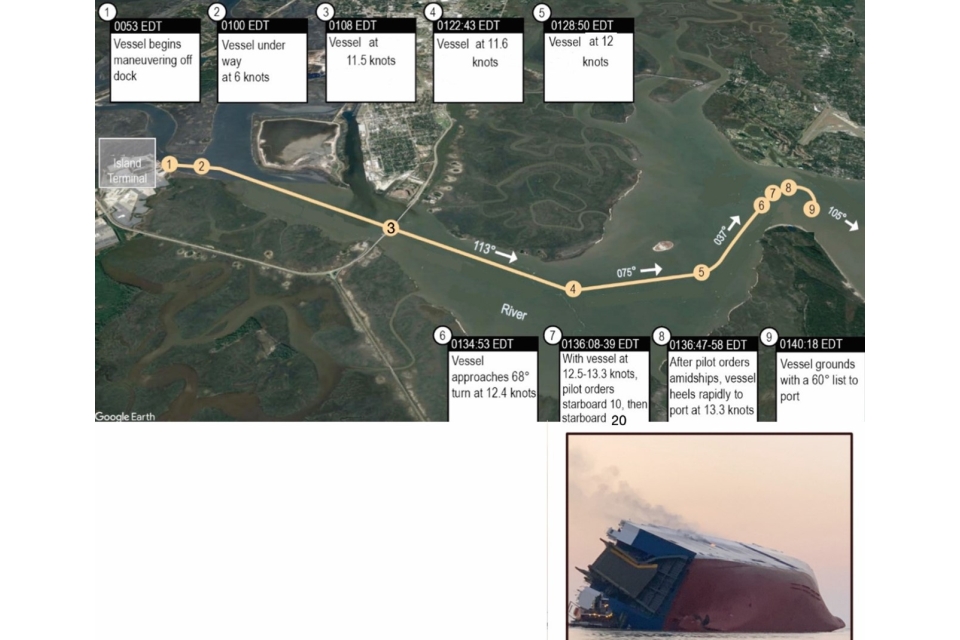Car carrier stability is a delicate matter, so officers need to be well-trained in the use of loading computers, warns The Nautical Insititute in its latest Mars Report. In this report, a data entry error resulted in a heel of 60° in less than a minute.
The Nautical Institute gathers reports of maritime accidents and near-misses. It then publishes these so-called Mars Reports (anonymously) to prevent other accidents from happening. A summary of this incident:
In the early morning hours, a car carrier departed port in a partially loaded condition. As the vessel progressed out to sea in a river channel, a 68° starboard turn in the channel was required. The pilot ordered 10° of starboard rudder.
There was no indication from anyone on the bridge that there were any concerns with the vessel, and no alarms sounded on the bridge. Shortly after, the pilot ordered 20° starboard rudder. Seconds later, he ordered the rudder returned to midships. But within seconds, the vessel started to heel significantly to port. The pilot ordered the helmsman to move the rudder to port to counter the increasing heel, but this action did not arrest the heel. The vessel reached a heel of 60° to port in less than a minute before grounding on the shallow area outside the channel.
Responders were initially able to rescue the pilot and nineteen of the 23 crew members on board. Four engineering crew members remained trapped in the engine room until the following day when responders cut into the vessel’s hull to rescue them. Thankfully, no fatalities were incurred during this accident, and only two serious injuries were suffered.
Monetary cost including the total loss of the vessel, cargo and salvage costs was estimated at more than USD 450 million.
Also read: VIDEO: Cargo vessel Sea Eagle starts listing and sinks in Turkey
Investigation findings
The official investigation found, among other things that; The car carrier’s GM at the time of the heeling was not more than 1.8 metres, well below the 2.45 metre GM reportedly calculated in the stability computer. The investigation postulates that the chief officer had entered the data for the ballast tanks into the stability computer manually, and in doing so had made a data entry error. This in turn led to an incorrect determination of the vessel’s stability.
At a higher level, the investigation found that the vessel operator did not have a method in place (training and auditing) to ensure that the chief officer, although experienced, was proficient in using the shipboard stability computer.
Also read: Wagenborg’s new multi-purpose vessel Máxima develops list in Port of Rotterdam
Advice from The Nautical Institute
- When only one person is responsible for a safety-critical task without a backup to help identify possible errors, single point failure can occur. Had the master taken a more active role in reviewing aspects of the vessel’s stability and the chief officer’s stability calculations, he may have been able to identify the error.
- Given the critical nature of stability calculations on car carriers, it is of utmost importance that operators ensure officers are well trained in the use of the loading computers on board, and that they have adequate procedures in place to guide crew in ballasting practice and sequencing.
Mars editor’s note: Notably, an investigation into a similar accident involving a car carrier in 2016 uncovered evidence that suggests sailing without a finalised and accurately calculated GM is a practice that extends to the car carrier sector in general. Without proper training it is likely that unsafe practices will become the norm. When unsafe practices become the norm, it is only a matter of time before an accident re-occurs.
Also read: Unstable lifeboat rolls over in calm water
Mars Reports
This accident was covered in the Mars Reports, originally published as Mars 202308, that are part of Report Number 364. A selection of this Mars Report was also published in SWZ|Maritime’s March 2023 issue. The Nautical Institute compiles these reports to help prevent maritime accidents. That is why they are also published (in full) on SWZ|Maritime’s website.
More reports are needed to keep the scheme interesting and informative. All reports are read only by the Mars coordinator and are treated in the strictest confidence. To submit a report, please use the Mars report form.








